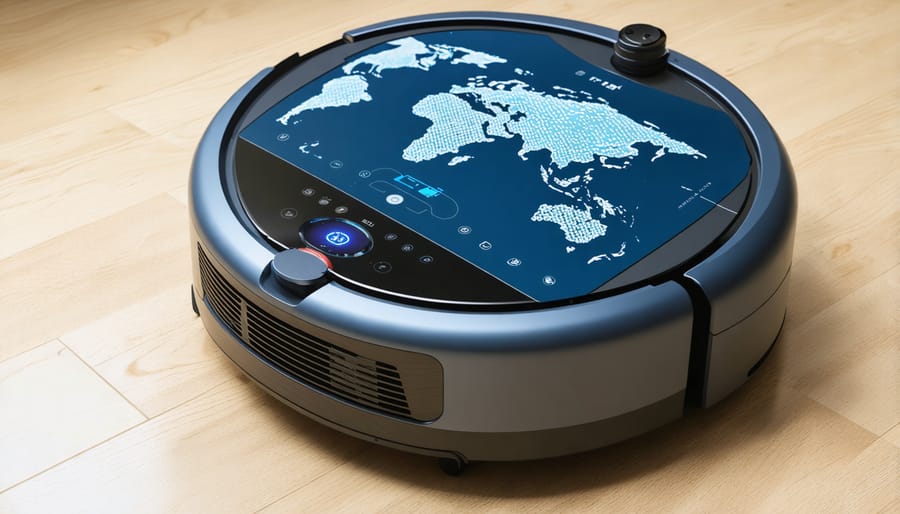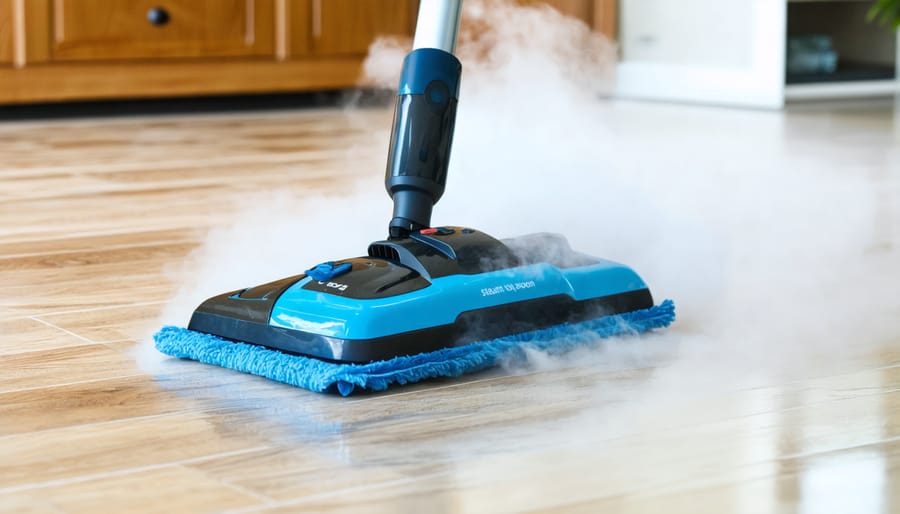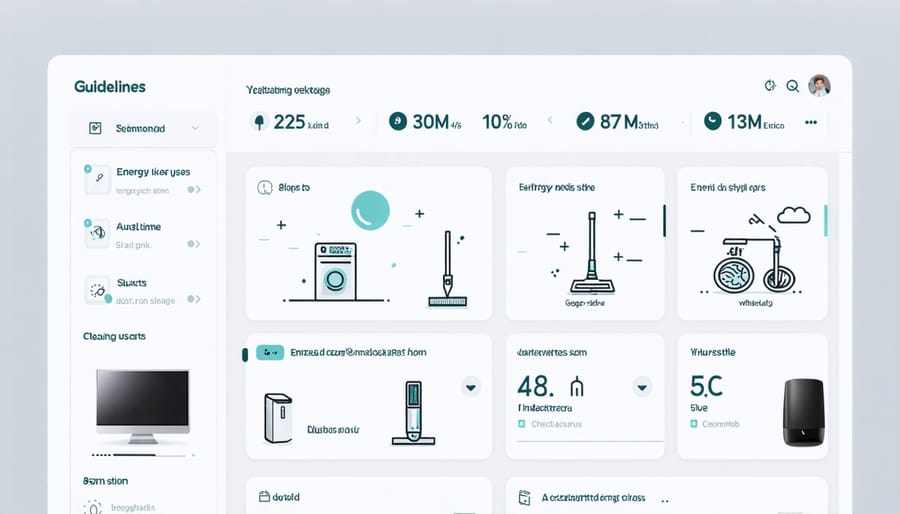Transform your daily cleaning routine with today’s revolutionary automated cleaning solutions that combine artificial intelligence, eco-friendly features, and cutting-edge technology. From robot vacuums that map your home’s layout to UV-sanitizing mops that eliminate 99.9% of bacteria, smart cleaning gadgets have evolved beyond simple automation into sophisticated home assistants. These devices not only save precious time but also reduce water consumption and eliminate harsh chemicals from your cleaning routine. Whether you’re a busy professional seeking efficiency or an eco-conscious homeowner wanting to minimize your environmental footprint, modern smart cleaning technology offers intelligent solutions that adapt to your specific needs and schedule. The latest generation of cleaning gadgets connects seamlessly with your smartphone, allowing you to maintain a spotless home even when you’re away, while their advanced sensors and AI capabilities ensure thorough cleaning with minimal energy waste.
Robot Vacuums That Think Green

Smart Scheduling and Energy Management
Modern robot vacuums have come a long way in making home cleaning both smarter and more energy-efficient. These clever devices now use AI-powered scheduling systems that learn your household’s routines and automatically adjust cleaning times to minimize disruption. By analyzing factors like foot traffic patterns and pet activity, they can determine the optimal cleaning schedule for each room.
Many advanced models feature smart power management systems that automatically adjust suction power based on floor type and dirt levels. When moving from hardwood to carpet, or encountering particularly dusty areas, they’ll increase power only when needed, helping conserve energy while maintaining cleaning effectiveness.
The latest smart vacuums can even coordinate with other smart home devices through your home automation system. They can pause cleaning when you’re on a video call, start working when everyone leaves the house, or schedule around your smart doorbell’s delivery notifications. Some models even use mapping technology to clean specific rooms during off-peak electricity hours, helping you save on energy costs.
To maximize efficiency, these devices often include maintenance reminders and cleaning reports through their companion apps. You’ll know exactly when to empty the dust bin or replace filters, ensuring optimal performance without wasting energy on inefficient operation. Many also feature eco-modes that extend battery life while providing adequate cleaning power for daily maintenance.
Eco-Friendly Filtration Systems
When it comes to keeping your home clean and healthy, eco-friendly filtration systems are game-changers. These innovative solutions combine smart technology with sustainable materials to trap allergens and pollutants while minimizing environmental impact.
Modern HEPA filters now come with washable and reusable components, eliminating the need for frequent replacements. Look for filters made from bamboo charcoal or other renewable materials – they’re just as effective as traditional options but significantly more sustainable. Many smart air purifiers now feature these eco-friendly filters, paired with sensors that monitor air quality and adjust filtration levels automatically.
For water filtration, ceramic and activated carbon filters offer excellent purification without the waste of disposable cartridges. Some smart systems even track water usage and filter life through smartphone apps, helping you optimize replacement timing and reduce unnecessary waste.
The latest vacuum cleaners incorporate washable microfiber filters that can last for years with proper maintenance. These filters capture microscopic particles while using less energy, and many models now include UV sterilization features for added effectiveness.
Pro tip: To maximize the lifespan of your eco-friendly filters, clean them regularly according to manufacturer instructions. Most can be gently washed with water and air-dried in sunlight, which naturally helps eliminate bacteria. This simple maintenance routine not only extends filter life but also ensures optimal performance and energy efficiency.
Smart Mops and Steam Cleaners
Water Conservation Features
Modern smart cleaning devices are leading the charge in water conservation, making a significant impact on both your utility bills and environmental footprint. Smart dishwashers now come equipped with sensors that detect load size and soil levels, adjusting water usage accordingly. These intelligent systems can save up to 3,870 gallons of water annually compared to hand washing.
Smart washing machines are equally impressive, featuring precision water level controls and innovative recycling systems. Many models now offer eco-cycles that use up to 55% less water while maintaining cleaning effectiveness through concentrated detergent distribution and optimized drum movements.
For outdoor cleaning, smart pressure washers with automated flow control prevent wasteful overspray, while robotic pool cleaners use advanced filtration systems that reduce the frequency of water changes. Some models even connect to weather forecasts to optimize cleaning schedules around natural rainfall.
The latest smart sprinkler systems for post-cleaning garden maintenance deserve special mention. They integrate soil moisture sensors and local weather data to prevent overwatering, potentially reducing outdoor water consumption by up to 50%. Many of these devices can be controlled through smartphone apps, allowing you to monitor and adjust water usage in real-time, making conservation both convenient and measurable.
Chemical-Free Cleaning Technology
Smart steam cleaners are revolutionizing the way we maintain our homes by harnessing the power of heat and water vapor to eliminate dirt, grime, and bacteria without harsh chemicals. These innovative devices offer a perfect solution for households looking to explore eco-friendly cleaning alternatives while maintaining a spotless living space.
Modern steam cleaners use advanced temperature controls and precise steam delivery systems to tackle various surfaces effectively. With temperatures reaching up to 200°F (93°C), these devices naturally sanitize surfaces by breaking down dirt particles and killing up to 99.9% of common household bacteria. The best part? All you need is water!
Smart features like automatic water level detection, variable steam control, and surface-specific settings make these cleaners incredibly user-friendly. Many models now come with smartphone connectivity, allowing you to monitor cleaning progress and receive maintenance reminders through dedicated apps.
For families with children or pets, steam cleaning technology offers peace of mind by eliminating the risks associated with chemical residues. The process is not only safer but also more cost-effective in the long run, as you’ll no longer need to stock up on various cleaning products. Plus, the environmental impact is minimal since you’re using only water and electricity.

Air Purification Technology
Smart Sensors and Air Quality Monitoring
Modern smart sensors are revolutionizing how we improve indoor air quality through intelligent monitoring and automated responses. These clever devices use advanced technology to detect various pollutants, from dust and pollen to volatile organic compounds (VOCs) and carbon dioxide levels.
What makes these sensors truly “smart” is their ability to adapt to your home’s specific needs. They continuously analyze air quality data and automatically adjust purification settings for optimal performance. When cooking smoke fills the kitchen or pet dander levels rise in the living room, these sensors spring into action, increasing filtration power where and when it’s needed most.
Many smart sensors also help you save energy by operating only when necessary. They can detect when rooms are empty and adjust accordingly, or power up before you return home from work. Through smartphone apps, you can monitor air quality metrics in real-time and receive alerts when conditions change. Some systems even learn your daily routines and preferences, creating a personalized schedule that maintains clean air while minimizing energy consumption.
Energy-Efficient Filtration
Modern smart cleaning devices are leading the charge in eco-friendly home maintenance with their innovative filtration systems and energy-saving features. Many of these devices now incorporate washable HEPA filters made from sustainable materials like bamboo fiber and recycled mesh, which can be reused for months before needing replacement.
The latest models come equipped with smart power management systems that automatically adjust suction power based on floor type and dirt levels. This intelligent adaptation not only preserves energy but also extends filter life. Some advanced units even complement these natural air purification methods with activated carbon filters that trap odors and harmful VOCs without consuming extra power.
Most impressive are the eco-modes featured in premium models, which optimize cleaning schedules during off-peak energy hours. These devices also include filter maintenance alerts, ensuring optimal performance while preventing unnecessary energy waste from clogged filters. By combining these energy-efficient features with sustainable filter materials, today’s smart cleaning gadgets help maintain a cleaner home while reducing both environmental impact and energy bills.
Integration and Smart Home Ecosystems
Voice Control and Automation
Imagine controlling your entire cleaning routine with just your voice! Modern smart home systems make this dream a reality, allowing you to orchestrate your cleaning gadgets through popular voice assistants like Alexa, Google Assistant, or Siri. Setting up these automated routines is surprisingly straightforward and can transform your cleaning schedule.
Start by connecting your smart cleaning devices to your home’s Wi-Fi network and linking them to your preferred voice assistant. Once connected, you can create custom commands like “Start kitchen cleanup,” which could trigger your robot vacuum to clean the kitchen floor while your smart air purifier kicks into high gear.
The real magic happens when you establish scheduled routines. For instance, program your devices to begin cleaning at specific times: “Every Monday at 10 AM, vacuum the living room” or “Run the air purifier for two hours after cooking.” These automated schedules ensure your home stays consistently clean without daily manual intervention.
Pro tip: Create location-based triggers using your smartphone’s GPS. Your cleaning routine can automatically begin when you leave for work, ensuring you return to a freshly cleaned home. Remember to regularly review and adjust your automated schedules to match your changing lifestyle and cleaning needs.
Energy Monitoring and Management
Modern smart cleaning devices come with sophisticated energy monitoring capabilities that help you keep track of power consumption and optimize usage patterns. Through dedicated smartphone apps, you can view real-time energy usage data, set power-saving schedules, and receive notifications when devices are consuming more energy than usual.
Many smart vacuum cleaners and mops now feature automatic power adjustment based on floor type and dirt levels, ensuring they use only the necessary amount of energy for each cleaning task. Some systems can even learn your cleaning patterns and suggest more energy-efficient schedules, like running during off-peak electricity hours.
Integration with smart home hubs allows you to monitor all your cleaning devices from a single dashboard. You can see which appliances are using the most power and make informed decisions about their usage. Smart plugs can automatically shut off devices that aren’t in use, preventing phantom energy drain.
To maximize energy savings, look for devices with eco-modes and those that support automation rules. For example, you can set your robot vacuum to clean only when solar panels are generating power or schedule maintenance during times when electricity rates are lowest. Many newer models also provide monthly energy reports, helping you track improvements in your home’s energy efficiency over time.

Making the Smart Switch
Making the switch to smart cleaning gadgets doesn’t have to be overwhelming. Start by identifying your household’s most frequent cleaning needs and choose one or two devices that address these specific challenges. For example, if you spend considerable time vacuuming, a robot vacuum might be your ideal first investment.
Begin with a smart cleaning schedule by replacing one traditional cleaning tool at a time. This approach allows you to learn each device’s features thoroughly and adjust your routines gradually. Many smart cleaning gadgets come with user-friendly apps that help you track cleaning patterns and customize settings to your preferences.
Consider the long-term benefits when evaluating the initial investment. While smart cleaning devices may cost more upfront, they often lead to significant savings in time, energy, and cleaning supplies. For instance, smart mops use precisely measured water amounts, reducing waste and extending your cleaning solution’s life span.
To maximize eco-friendly benefits, look for devices with energy-efficient ratings and those that use minimal water or cleaning agents. Many modern smart cleaners feature HEPA filtration systems that trap allergens and microscopic particles, improving your home’s air quality without harsh chemicals.
Integration is key to building an effective smart cleaning ecosystem. Choose devices that work with your existing smart home platform, whether it’s Alexa, Google Home, or Apple HomeKit. This compatibility ensures seamless operation and allows you to create automated cleaning schedules that work around your lifestyle.
Start small with these practical steps:
– Replace traditional cleaning supplies with reusable, washable alternatives
– Set up automated cleaning schedules during off-peak energy hours
– Monitor water and energy usage through device apps
– Maintain and clean your smart devices regularly to ensure optimal performance
– Keep backup filters and parts on hand for uninterrupted cleaning
Remember to properly dispose of or donate your old cleaning equipment. Many communities have recycling programs for electronic devices and cleaning tools. As you transition, you’ll notice not just a cleaner home, but also reduced utility bills and a smaller environmental footprint.
The key to success is patience and consistency. Take time to understand each new device’s capabilities and gradually expand your smart cleaning arsenal as you become more comfortable with the technology. Soon, you’ll wonder how you ever managed without these innovative cleaning solutions.
